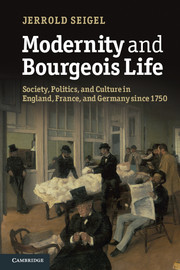 Modernity and Bourgeois Life
Modernity and Bourgeois Life Book contents
- Frontmatter
- Contents
- Illustrations
- Preface
- 1 Introduction: ends and means
- Part I Contours of modernity
- 3 Monarchical centralization, privilege, and conflict: France
- 4 Localism, state-building, and bürgerliche Gesellschaft: Germany
- 5 Modern industry, class, and party politics in nineteenth-century England
- 6 France and bourgeois France: from teleocracy to autonomy
- 7 One special path: modern industry, politics, and bourgeois life in Germany
- Part II Calculations and lifeworlds
- 9 Men and women
- 10 Bourgeois morals: from Victorianism to modern sexuality
- 11 Jews as bourgeois and network people
- Part III A culture of means
- 13 Bourgeois and others
- 14 Bourgeois life and the avant-garde
- 15 Conclusion
- Notes
- Index
1 - Introduction: ends and means
Published online by Cambridge University Press: 05 June 2012
- Frontmatter
- Contents
- Illustrations
- Preface
- 1 Introduction: ends and means
- Part I Contours of modernity
- 3 Monarchical centralization, privilege, and conflict: France
- 4 Localism, state-building, and bürgerliche Gesellschaft: Germany
- 5 Modern industry, class, and party politics in nineteenth-century England
- 6 France and bourgeois France: from teleocracy to autonomy
- 7 One special path: modern industry, politics, and bourgeois life in Germany
- Part II Calculations and lifeworlds
- 9 Men and women
- 10 Bourgeois morals: from Victorianism to modern sexuality
- 11 Jews as bourgeois and network people
- Part III A culture of means
- 13 Bourgeois and others
- 14 Bourgeois life and the avant-garde
- 15 Conclusion
- Notes
- Index
Summary
Modernity, money, networks of means
Toward the middle of the nineteenth century many people agreed – not always happily – that Western Europe was giving birth to a new form of life, often called modern, in which bourgeois activities, people, attitudes, and values all played a large role. How should we understand the relations between this European modernity and the bourgeois life that was so important an element in it? The question is a thorny one for many reasons, first because what people meant by the two terms is far from clear.
“Modern” was an uncertain notion partly because it was not a new one, in use to describe present or recent times at least from the sixteenth century, and partly because the things to which it was applied differed from place to place, not least in the three large countries whose nineteenth-century transformations were most striking: England, France, and Germany. A similar uncertainty surrounded the range of phenomena designated by “bourgeois,” or rather by the French term and its German and English counterparts, bürgerlich and middle class. The social formations called up by the three were kindred but also distinct, and each term reflected a particular historical experience. A bourgeois was originally a town-dweller, especially one who possessed some special status or privileges; a Bürger was a townsperson too but the German word also meant a citizen, a difference that would be of some moment in the history of both; as for “middle class,” it was the least specific of the set, and unlike the others never designated a legally defined group. The shifting and uncertain meanings of both “modern” and “bourgeois,” combined with the generations of controversy that have accumulated around each, make attempting to start out with a precise definition of either a bootless task. But the links often posited between them suggest that we may be able to move toward a better understanding by considering them together.
- Type
- Chapter
- Information
- Modernity and Bourgeois LifeSociety, Politics, and Culture in England, France and Germany since 1750, pp. 1 - 38Publisher: Cambridge University PressPrint publication year: 2012


